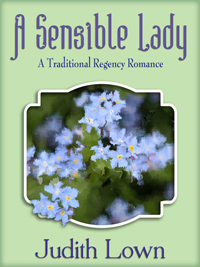The Roots of Regency Romance: A primer for authors
Judith Lown is the author of A Match for Lady Constance (Avalon) and A Sensible Lady: A Traditional Regency Romance (eFrog Press). She is hard at work on a sequel but still makes time to blog.
 The first Regency Romances weren’t historical; they were contemporary fiction written by Jane Austen. But her work established critical standards that are still used to evaluate romantic fiction today—200 years after she wrote. Any literate female who reads English will be able to tell you when she first read an Austen novel and which is her favorite.
The first Regency Romances weren’t historical; they were contemporary fiction written by Jane Austen. But her work established critical standards that are still used to evaluate romantic fiction today—200 years after she wrote. Any literate female who reads English will be able to tell you when she first read an Austen novel and which is her favorite.
The first historical Regency Romances were written by Georgette Heyer from 1934-1972. It was Heyer who introduced the ton—London’s most select society—to fiction readers. And her unique perspective on what makes a lady admirable and what makes a gentleman honorable is the yardstick by which connoisseurs of traditional Regencies still measure Regency Romance writers.
Both Austen and Heyer are romance writers, but neither can be called Romantic Writers in a literary sense. The Bronte sisters are prime examples of Romantic Writers. Bronte heroines live in a world of high emotion and extreme behavior. Austen and Heyer are in the classical tradition, which emphasizes self-control, restraint, and balanced judgment—even in the face of distressing circumstances.
What we have in both Austen and Heyer heroines is something much more serious than “pluck to the backbone.” It is a toughness of mind that, while not denying longing and love, faces unpleasant realities without self-pity.
When writing A Sensible Lady: A Traditional Regency Romance, I consciously asked myself “What attitude would Heyer take?” when I was dealing with the potentially dire situation in which my heroine, Katherine Brampton, found herself. She had to be courageous but discreet, realistically worried but not hysterical or whiny. No one threaded those needles with the skill of Austen and Heyer.
And what about heroes? Mr. Darcy and Mr. Knightly are proverbial for their upholding of Society’s standards and their insistence that conventions be observed—even at the risk of losing the loves of their lives. Likewise, Heyer’s heroes might have their peccadilloes. They might be arrogant or rude. But they understand the rules that bind the lives of the ladies they love and they adjust their behavior accordingly. Lord Worth waits until Judith Tavener reaches her majority and is no longer his ward before he courts her. Lord Damerel, a man with a dissolute past, refrains from seducing a vulnerable Venetia. Indeed, in Heyer’s entire Regency oeuvre, there is only one elopement, and even it is conducted in a rational manner.
Again, when portraying Lord Henry Dracott, the hero of A Sensible Lady, Heyer’s heroes provided me with models of how the demands of civilized society in the Regency period were negotiated by gentlemen who, by nature, were impatient with nuance and emotions.
Currently, the most popular historical novels that take place in the first two decades of the 1800’s are called “Historicals of the Regency Period.” These are emotionally intense, sexually explicit romances. Many are flawlessly accurate in historical details. The equipage of a carriage—even the type of carriage—is painstakingly described. Actual historical events are faithfully represented. It wouldn’t be surprising if the weather of a certain date reflected contemporaneous weather reports. But the behavior of the hero and heroine is more reflective of 2012 than 1812. Some of these books are wonderfully written and very entertaining. But the men and women who populate them have much more to say about twenty-first century relationships than nineteenth century relationships.
What both Austin and Heyer examine in their romances is how men and women—ladies and gentlemen—seek and earn personal happiness while remaining within the strictures of a demanding social order. While maintaining factual historical accuracy, writers of Traditional Regencies also try to reflect the social realities of the period.
What aspects of historical accuracy do you think are most important? What lapses are so irritating that you stop reading?
Tags: Georgette Heyer, Jane Austen, Regency romance, traditional Regency romance
